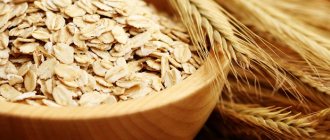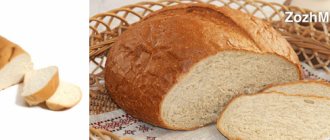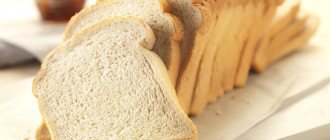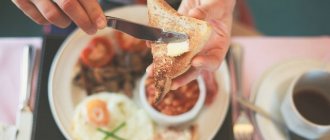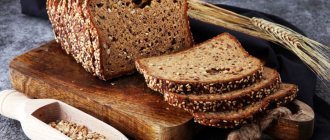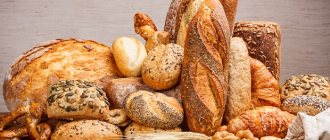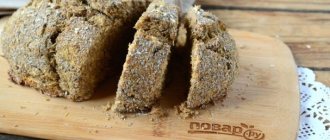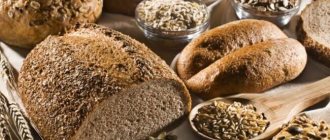When losing weight, you cannot completely exclude all types of bread products. During weight loss, it is necessary to prevent deficiency of vitamins and minerals in the body. When limiting the consumption of certain foods, a person begins to receive less nutritional components.
Nutritionists insist that eating bread is necessary. It is rich in a lot of vitamins and chemicals. However, not all types of food can be eaten while losing weight. The best solution is to make your own bread.
Carbohydrate content in bread
Bread is a product that contains a large amount of carbohydrates. They are divided into two main groups. Among them are simple and complex. The largest amount of simple carbohydrates is found in products made from wheat flour.
It is not recommended to use them during weight loss due to the glycemic index, which contributes to a rapid increase in blood sugar levels. When it enters the body in excess, carbohydrates are converted into adipose tissue.
The body receives complex carbohydrates from rye or whole grain bread. To convert them into energy, the body requires more time due to the launch of complex biochemical processes. As a result, there is a slow increase in glucose in the blood and the body spends this energy only on the work of the brain, muscles and internal organs.
Which bread is healthier: we figure it out together with experts
Ten centuries ago, bread was a sign of prosperity, but today it is increasingly becoming a subject for discussion: to eat or not to eat, healthy or not, with or without yeast... Read what experts say about this.
To eat or not to eat
According to analysts at Gfk (a global analytical platform for the consumer goods industry), bread consumption fell by 57% over the year among low-income families aged 50+. At the same time, the bread consumption of families with an average income aged 30+ increased by 43%.
Analysts attribute these statistics to the fact that the format of remote work is changing consumption and habits; snacks during working hours are taken at home and become healthier. This is confirmed by the dynamics of demand:
- consumption of gluten-free bread increased by 458% over the year,
- bread fitness line - by 13%,
- bread from the “healthy” category - by 10%.
Read in our articles how to prepare bread without yeast and without flour.
Doctors and nutritionists attribute such statistics to the fact that people have become more attentive to their health and are reconsidering the principles of nutrition. However, those who completely exclude bread from their diet are not supported.
Natalia Khlustova, endocrinologist:
— Bread is a source of carbohydrates, dietary fiber, vitamins, including B vitamins, micro- and macroelements, such as magnesium, selenium, iron. In a balanced diet, carbohydrates should make up 50%. A healthy person can safely consume 1–3 slices of bread per day, which is about 100 grams. The greatest amount of nutrients is contained in products made from whole grains with the addition of bran.
What to look for in bread
Try to carefully read the ingredients of a classic sliced loaf with an honest composition (that is, without artificial flavors, preservatives and improvers). You will not find anything potentially dangerous or harmful in the ingredient list. Ingredients: wheat flour, vegetable oil, sugar, salt, yeast, water. Moreover, 100 grams of the product contains only 262 kcal.
What you can definitely find in 100 grams of sliced loaf (in% of the daily value):
- 7.2% protein
- 48.5% starch
- 2.9% mono- and disaccharides
- 2.5% dietary fiber
- 1.5% fat
- 1.2% iron
- 1.7% vitamin E
- 0.11% vitamin B1
- 0.9% vitamin PP
- 2.1% niacin
Tutelyan V.A. “Chemical composition and calorie content of Russian food products”
The sliced loaf contains vitamins B and E, iron, magnesium, calcium, potassium and phosphorus. It is a source of energy and allows you to quickly restore strength.
But we must not forget that the sliced loaf contains gluten, which means it is contraindicated for people with celiac disease. It is also not recommended for diabetics, since its glycemic index is about 80, although this is no more than that of boiled carrots. For more information about what these numbers mean and how to interpret them, read the material “What is the glycemic index.”
Dieticians and nutritionists support the assertion that bread is an indispensable part of a healthy plate of food.
Victoria Vishnyakova, nutritionist:
— Bread belongs to the group of grains - one of the five food groups recommended for consumption. It is possible to completely remove bread from your diet, but only if you simply don’t like it. But I recommend that you definitely replace it with any other form of grain, such as cereal. And if you love bread, then eat it for your health!
What about calories?
The results of a survey of VkusVilla customers show that 27% gave up bread to reduce the amount of carbohydrates in their diet, another 12% consider bread harmful to their figure.
Let's do the math. Bread consumption in Russia is approximately 130 grams per day per person.
The calorie content of bread depends on the ingredients included in the composition. Products made from wheat flour have a calorie content of 230–260 kcal, and bread using rye flour has a calorie content of 200–230 kcal. It is easy to calculate the approximate daily calorie content of baked goods consumed - from 260 to 320 kcal. The body’s energy expenditure will leave about 30% of the “eaten” calorie content of bread, which can easily be burned with 30 minutes of physical activity or household chores.
Before writing the article “5 popular myths about bread,” we ourselves believed in most of them. Did you know the truth?
Which bread to choose
Manufacturers really offer an incredible amount of different breads. In the VkusVilla catalog alone there are six categories:
- sourdough bread;
- yeast bread;
- baked goods;
- bread, crackers, biscuits, crackers;
- bagels, drying, crackers;
- national bread.
And this is without dividing into rye, wheat and bread made from different types of flour. Let's try to understand the most popular varieties and decide which bread to choose.
Rye bread
Glycemic index – 50–58.
Calorie content - 175 kcal/100 g.
A product with an average carbohydrate load and high nutritional value, when consumed in moderation, does not provoke excess weight gain and gives a long-lasting feeling of satiety. Rye bread contains fiber, iron, magnesium, and amino acids.
The darker the color of the bread, the more rye flour it contains, which means the lower its GI, but the higher the acidity. It is not advisable to combine it with meat, since such a combination complicates the digestion process. It is optimal to eat this bread with light vegetable salads and soups.
Borodino bread
Glycemic index - 45.
Calorie content - 206 kcal/100 g.
Borodino bread is rich in B vitamins (not inferior to meat), macro- and microelements. It contains more complete protein than any other bread. Vitamin B1, or thiamine, which is quite abundant in Borodinsky, is important for the functioning of the nervous system. It is well absorbed by the body, beneficial for digestion processes, and cumin, coriander or anise, with which it is sprinkled, helps remove uric acid from the body.
Bran bread
Glycemic index - 45.
Calorie content - 227 kcal/100 g.
Due to the presence of coarse dietary fiber, bread with bran takes a long time to digest and does not cause sharp fluctuations in blood glucose levels, which is important for people with diabetes. It saturates the body with B vitamins, improves normal intestinal function, improves immunity due to antioxidants in the composition, and gives a feeling of satiety for a long time without the feeling of heaviness and bloating.
Grain bread
Glycemic index - 45.
Calorie content - 252 kcal/100 g.
Contains bran and grain germs, which saturate the body with fiber, vitamins and minerals. In whole grain bread, the grain retains its shell, which contains the maximum amount of beneficial enzymes, amino acids and vitamins. The baking temperature for whole grain bread rarely exceeds 99°C, so part of the natural microflora of the grain remains in the finished product.
Evgenia Kuzmenko, nutritionist:
— Very often the concepts of proper nutrition and healthy eating are replaced. It has become fashionable to consider foods that have a reduced calorie content and do not lead to extra pounds as proper nutrition. Bread is an important component of proper nutrition. The benefits of bread will depend on the correctness and purity of its composition and, of course, on the quantities in which you eat it. There should be nothing in the bread except grain, salt, water, and leaven. Coarse flour is optimal, for which whole grains are used, for example, rye flour, green buckwheat flour, almond or coconut.
In the article “Lyapuny and Slippers: Get to Know VkusVilla’s Bread Hits,” we talked about the most unusual types of bread from our assortment.
What kind of bread to eat is up to you to choose. But you definitely need to take into account your health status and follow moderation.
About bread: questions and answers
We have collected the most frequently asked questions from our customers about bread and will give short and succinct answers to them.
Are toasts, fried bread, croutons, and crispbreads healthy?
In the case of toast and croutons, as with fresh bread, be sure to read the ingredients. And if you are watching your figure, then the nutritionist will probably recommend that you replace fresh bread with dried bread. The glycemic index of toast and crackers is about 50 - versus 80 for fresh bread. In this case, you need to dry or fry the bread without adding oil.
In the case of bread rolls, you will also have to carefully read the ingredients. It should not contain:
- wheat flour;
- Sahara;
- modified starch, preservatives, dyes, antioxidants and other artificial additives.
Is there yeast in unleavened bread?
You will be surprised, but “yeast-free” bread still contains yeast, since these microorganisms are the reason for the fermentation of the dough, as a result of which it loosens. Yeast is not listed in the composition, since not an industrial (pure) culture is used, but a sourdough starter that also contains lactobacilli. So any “yeast-free” bread will still contain yeast.
But, as specialists in microbiological research at the Research Institute of the Baking Industry emphasize, there is no yeast in finished bread; they die during baking. That is, they will be present in the composition, but they will not be able to enter the body in a living form.
Yeasts are mesophilic microorganisms with a temperature optimum of 29–30 °C. Temperatures above 45–50 °C are destructive for them. There are no living yeast cells left in the finished bread. The temperature of the crumb of freshly baked bread is 96–98 °C, the crust is 160–180 °C. No living microorganisms, including yeast cells, can survive at this temperature. The bread comes out of the oven almost sterile.
Both yeast and yeast-free bread contain useful substances. Therefore, there is no point in avoiding any type of bread or giving preference to “healthier” ones. Choose the one you like: yeast or sourdough.
As representatives of the research institute write, the recipe component of sourdoughs is flour, which already contains Saccharomycetes yeast. Finding themselves in favorable conditions, they manifest themselves during a spontaneous fermentation process. Thus, the microflora of sourdoughs is a symbiosis between yeast and lactic acid bacteria. Yeast ensures the rise, loosening of the dough and the formation of a porous crumb, and lactic acid bacteria give the bread taste and aroma.
This type of bread is called long-aged bread. Accordingly, it takes more time to prepare it than usual, and baking it on an industrial scale is not very profitable. This is mainly done by small industries and craft bakeries. Among VkusVilla’s suppliers there are such - read about original bread from the Yaroslavl region and village tartine bread.
In our bread line we have collected several types of yeast-free bread, there is bread without flour, without sugar: “Healing” with chicory”, “Rye-wheat without flour”, “Zhitny”, “Romanovsky”, “Simeonovsky”, “Diveevsky”.
“You can feel the taste of real grain, natural,” says customer Tatyana about Zhitny bread. “Even the child likes it.”
“The bread turned out to be very light,” Elena wrote in the comments. — Perfect for breakfast with cottage cheese, for example. Or you can put avocado puree and a piece of salmon on a piece slightly dried in a frying pan - you will have a wonderful avocado toast. It seems to me that this is almost a dietary product.”
Gluten-free bread: benefit or harm?
Why do we hear so often now about gluten intolerance? According to statistics, only 5% of the population of our country suffer from confirmed gluten intolerance, or celiac disease (protein intolerance to certain cereals). However, there are more and more products containing gluten, which means that the number of people with sensitivity to it is increasing. Hence the more frequent discussions on this topic.
“Indeed, over the past 20 years, the number of products containing gluten has increased by about 20%,” says nutritionist Evgenia Kuzmenko. — As a result, the number of people who have sensitivity to gluten has increased, which means problems with the gastrointestinal tract and deficiency conditions in the body. You can conduct a simple experiment: exclude foods containing gluten for several days and observe the condition of the skin, gastrointestinal tract, bloating, heartburn, morning phlegm or cough.
If you have a gluten sensitivity, traditional baked goods will need to be replaced with gluten-free ones. VkusVill customers recommend trying “Chickpea” bread. Here's what they write in reviews on the site:
“Wonderful bread, you can’t imagine anything better in terms of nutritional and energy value, ideal for those who are watching their figure. It contains only chickpea, rice and flax flour, a storehouse of microelements. Incomparable in terms of usefulness with ordinary bread. I will definitely buy more,” notes buyer Marina.
“The child with allergies liked it. The shape of the bread is original, like an Easter cake. The price is affordable. We’ll take it, I think,” Svetlana supports.
Nutritionist Victoria Vishnyakova also advises taking a closer look at gluten-free bread:
— If your body is sensitive to gluten, then replace traditional bread with gluten-free bread, gluten-free bread or baked goods made from rice, corn or oatmeal.
Write down the recipe - green buckwheat bread
If you like to bake yourself, we recommend a recipe for green buckwheat bread from nutritionist Evgenia Kuzmenko.
You will need:
- green buckwheat – 300 g
- 2 bananas
- 2 eggs (can be replaced with chia seeds)
- flax seeds
- pumpkin seeds
How to cook:
1. Soak buckwheat in water and leave overnight. In the morning, rinse it thoroughly and grind it in a blender.
2. Add eggs, bananas, mix until smooth.
3. Add flax seeds and spices to taste.
4. Place the dough in the pan and sprinkle pumpkin seeds on top. Bake in the oven at 180°C for 30–40 minutes. This bread is best stored in the refrigerator.
What kind of bread do you like? Have you tried baking yourself? Tell us in the comments.
What happens if you completely give up bread?
With a complete and rapid refusal of carbohydrates, the development of pathological reactions from the body is possible. Among them are:
- Incessant headache. A complete refusal of bread can lead to a lack of carbohydrates in the body, from which glucose is produced, which is a source of energy. The brain is one of the organs that primarily responds to a lack of nutrients.
- Constant fatigue due to insufficient energy supply.
- Tendency to depression. Low glucose levels cause insufficient serotonin production. In the initial stages, the patient may experience depressed mood and constant anxiety, which is replaced by unmotivated aggression and depression.
- Disorders of the digestive tract. Avoiding bread leads to insufficient fiber intake. As a result, intestinal motor function decreases and the likelihood of fermentation and dysbacteriosis increases.
- Constant feeling of hunger. Lack of glucose in the body leads to a constant feeling of hunger. To reduce the severity of this symptom, it is necessary to consume a sufficient amount of complex carbohydrates.
- Hormonal imbalance.
Calorie content and nutritional value of various types of bread
Different types of bread differ not only in composition, but also in nutritional value.
Table 1. Amount of BJU and Kcal in different types of bread.
| Product | Kcal | Squirrels | Fats | Carbohydrates |
| Wheat bread | 266 | 7,7 | 2,4 | 53,4 |
| Rye bread | 224 | 4,7 | 0,7 | 49,8 |
| Grain bread | 215 | 8,5 | 1,6 | 38,58 |
| Armenian lavash | 258 | 9,2 | 1,1 | 58,2 |
We invite you to watch a video with tips on what kind of bread you should eat to avoid gaining weight:
Crackers and croutons
Bread in this form does not stimulate the intestines, but, on the contrary, strengthens it. Dried bread has less stickiness and is more beneficial for the gastrointestinal tract than fresh bread. The calorie content of dried and fresh bread is the same. The energy value depends on what variety you use and what you fry it on: a slice of wheat bread fried in butter will bring you 105 kcal.
Macro and microelements in bread
High-quality bread contains the necessary macro- and microelements, as well as vitamins, which ensure the full functioning of the body.
The greatest amount of useful substances is found in products with bran or made from whole grain flour.
The daily intake of bread contains the maximum amount of selenium. This microelement is necessary for the full functioning of various biochemical processes.
When whole grains are included in the diet daily, up to 30% of manganese is replenished, which acts as an antioxidant necessary for metabolic processes in mitochondria.
In addition, with sufficient intake, metabolic processes with carbohydrates, proteins and cholesterol are restored. Bread can provide up to 5% of the daily value of such substances as calcium, phosphorus, iron, magnesium, sodium, zinc and copper.
With bran
This bread is baked from wholemeal flour, made from healthy unrefined grains (along with the shell and germ). This product is the undoubted leader in a healthy diet, as it is rich in nicotinic acid, a substance that protects the body from gastrointestinal diseases and prevents atherosclerosis. The calorie content of bread with bran is 227 kcal per 100 g.
Is it possible to eat bread when you are losing weight?
Most people who decide to lose weight first eliminate or minimize the amount of bread from their diet. Complete cessation of its use leads to a negative effect on the body.
This diet product is capable of:
- Positively influence digestive function due to fiber. As a result, waste and toxins are removed.
- Stimulate the breakdown of fats, since the process of their destruction is triggered by carbohydrates. In addition, in addition to simple carbohydrates, the composition also contains complex carbohydrates. They provide a feeling of fullness for a long time.
- Replenish the amount of vegetable protein, which acts as a building material for cells, as well as vitamins and minerals.
- Produce endorphins and serotonin due to the taste of the product. It is necessary to take into account that different types of bread have different glycemic index - an indicator indicating the duration of absorption of the product. When dieting, it is important to select varieties with a low glycemic index, which are absorbed from the digestive tract for a long time and do not provoke appetite. These include Borodinsky or whole grain bread, while white bread must be completely abandoned.
In addition, to lose weight, you must follow several basic rules when consuming baked goods while losing weight. Among them are:
- Elimination of other carbohydrates when including bread in the diet. To reduce body weight, it is recommended to combine it with protein foods.
- Limit a single dose to 100 grams, in order not to exceed the permissible number of calories.
- Avoid product in the evening.
- Creation of fasting days with its complete exception.
General tips for use
White bread is rich in calories, so it is very beneficial for athletes after training - at this moment, the open “carbohydrate” window is ready to accept any amount of calories and absorb it without storing it as fat reserves. In addition, 25 grams of meat contains as much protein as the protein in bread. However, eating bread for those leading a sedentary and passive lifestyle will not provide any benefit - it will only create a feeling of fullness for a short time, after which the feeling of hunger will wake up again.
Bread made from whole grains and wholemeal flour is very healthy and enriches the body with only useful things. However, it is considered a rather coarse product, which can complicate digestion in case of problems with the gastrointestinal tract and worsen a person’s already painful condition.
Rye bread is the best option. It is very popular both among athletes and people leading a healthy lifestyle. In addition, it is much healthier if prepared using sourdough. It can help with dysbiosis and stomach diseases.
Bread for children, which is better, in what quantities
The preparation of a daily diet for children must comply with standards that will ensure full physical and neuropsychic development. The supply of sufficient energy, various vitamins and microelements prevents developmental delays and the formation of vitamin deficiency.
Bread is one of the products that should be present in the diet every day. They are included in the child’s menu from one year old. It is recommended to start complementary feeding with white bread, as it is easily absorbed and digested.
By the age of one and a half years, rye bread is also added to the menu. It is one of the healthier products compared to wheat, as it contains a sufficient amount of B vitamins, dietary fiber, and plant proteins.
The daily norm for children under one and a half years old should not exceed 20 grams of rye bread and 40 grams of wheat. From one and a half to three years, 30 and 60 grams. If baked goods, such as cookies or rolls, are added to the child’s menu, the amount of wheat bread is reduced.
Composition of white flour product
The main components of bread are wheat flour and clean water. Wheat flour is not as healthy as rye flour; it contains few vitamins and plant fibers, but it does contain a sufficient amount of starch, carbohydrates and gluten.
The second and quite important ingredient is yeast. They help the dough rise, so the finished product is fluffy and soft. Yeast enriches bread with amino acids and biologically active beneficial substances.
In bakeries, chicken eggs are sometimes added to the dough, which is why the finished baked goods have a yellowish tint. The advantage of eggs is their protein content, the disadvantage is the reduction in the shelf life of flour products.
Sometimes an ingredient such as bran is added to the dough, they are very healthy and thanks to them the nutritional value of the product increases (first of all, bran is rich in fiber and vitamins). To diversify the product recipe, bakers add spices, dried fruits, nuts and all kinds of spices.
The composition of white bread includes: monosaccharides and disaccharides, starch, protein, fiber, organic acids, fats, vitamins (, , ), micro- and macroelements, water.
The caloric content of 100 grams of product is equal to 260 kilocalories. You can evaluate the nutritional value of wheat bread and other products using the appropriate table. Energy value of some breads (per 100 grams of product)
| Product name | Proteins, g | Fats, g | Carbohydrates, g | Calories, kcal |
| loaf | 8 | 3 | 50 | 262 |
| Borodinsky | 7 | 1 | 40 | 41 |
| Wheat | 8 | 1 | 48 | 242 |
| Rye | 8,6 | 3 | 59,8 | 206 |
| Buckwheat-rye | 11 | 2 | 58 | 310 |
| Oatmeal with bran | 7 | 2 | 43 | 225 |
White bread is very nutritious; one slice contains approximately 106 kilocalories. Therefore, in the morning, people often prefer to eat a sandwich to replenish their own energy and be full.
Bread for the elderly
For elderly people, it is necessary to carefully consider the preparation of the daily menu. In many ways, nutritional habits change due to age against the background of acquired diseases and changes in the functional activity of the digestive tract.
First of all, it is necessary to take into account the presence of acquired pathologies. Among them, the most common are type 2 diabetes mellitus, colitis and gastroduodenitis of various origins.
Diabetes requires daily menu control, and white bread and various baked goods have a high calorie content due to simple carbohydrates.
Useful video
About the bread diet, watch this video:
Similar articles
- Vegetarian diet: how to lose 10 kg, make...
For those who love meat, a vegetarian diet will become quite difficult. However, with it you can lose weight by as much as 10 kg. It’s not difficult to create a delicious menu of protein foods for the week, especially in the summer. There are interesting recipes for vegetable soup. It is important to know the foods that are allowed and prohibited. Read more - Diabetes and diet for weight loss: dos and don’ts...
If you have diabetes, a weight loss diet will help maintain insulin. It is important to understand how, whether and when not to lose weight with type 1 and type 2 diabetes. Read more
- Meat-free diet for weight loss: menu, is it possible to do without...
Various methods are used to lose weight, including some who prefer a meat-free diet for weight loss. You can create a menu yourself. In some cases, for a good result, you can exclude fish. Read more
Harm from bread
Despite the benefits that bread has when entering the body, there are also negative factors associated with its consumption. Its harm depends on the type of product that is introduced into the human diet.
When eating white bread, the following are distinguished:
- Increased blood viscosity.
- Disturbance of intestinal microflora. Excessive intake of products made from wheat flour enhances the fermentation process and slows down peristalsis, which provokes constipation, discomfort and pain in the abdominal area.
- Metabolic disorders, as well as an increased risk of obesity. White bread is considered a high-calorie product with a low content of vitamins and microelements. This is due to the high degree of processing of wheat grains and the loss of useful substances with waste particles.
When eating rye bread, the following are distinguished:
- Digestive disorders associated with the presence of coarse fibers.
- Irritant effect of the product on the gastric mucosa. If consumed regularly in large quantities, it can cause heartburn, stomach pain and belching due to increased acidity.
- Reduced absorption of nutrients due to coarse fiber contained in the composition.
- Digestive disorders due to gluten intolerance.
Composition and beneficial properties
When consuming bread products, the body receives fiber, which helps improve the functioning of the digestive organs. When losing weight, a person experiences stress. The cereal product normalizes the nervous system.
Therefore, you should not completely give up bread. The most useful is rye. It contains many healing components, as well as the following vitamins:
- retinol;
- tocopherol;
- lipophilic compounds (vitamin K).
Chemical composition of bread:
- iodine;
- sodium;
- manganese;
- chlorine;
- potassium;
- zinc;
- silicon;
- selenium;
- magnesium;
- copper;
- cobalt.
If you deprive the body of the minerals and vitamins found in bread, this will lead to increased fatigue, short temper, and depressive disorders.
Slow carbohydrates and amino acids stimulate muscle growth. Other beneficial properties of flour products include:
- lack of fast carbohydrates;
- content of substances necessary for the heart (magnesium, potassium);
- high energy value;
- long-term absorption.
